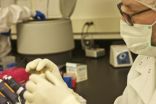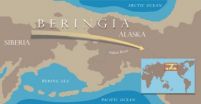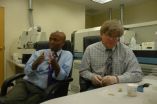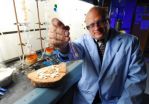Oldest most complete, genetically intact human skeleton in New World
Remains of 12,000- to 13,000-year-old teenage girl found in underwater Mexican cave establish definitive link between earliest Americans and modern Native Americans
2014-05-15
(Press-News.org) WASHINGTON (May 15, 2014)—The skeletal remains of a teenage female from the late Pleistocene or last ice age found in an underwater cave in Mexico have major implications for our understanding of the origins of the Western Hemisphere's first people and their relationship to contemporary Native Americans.
In a paper released today in the journal Science, an international team of researchers and cave divers present the results of an expedition that discovered a near-complete early American human skeleton with an intact cranium and preserved DNA. The remains were found surrounded by a variety of extinct animals more than 40 meters (130 feet) below sea level in Hoyo Negro, a deep pit within the Sac Actun cave system on Mexico's Yucatán Peninsula. The Hoyo Negro project was led by the Mexican government's National Institute of Anthropology and History (INAH) and supported by the National Geographic Society.
"These discoveries are extremely significant," said Pilar Luna, INAH's director of underwater archaeology. "Not only do they shed light on the origins of modern Americans, they clearly demonstrate the paleontological potential of the Yucatán Peninsula and the importance of conserving Mexico's unique heritage."
The findings detailed in Science are noteworthy on numerous levels:
This is the first time researchers have been able to match a skeleton with an early American (or Paleoamerican) skull and facial characteristics with DNA linked to the hunter-gatherers who moved onto the Bering Land Bridge from northeast Asia (Beringia) between 26,000 and 18,000 years ago, spreading southward into North America sometime after 17,000 years ago.
Based on a combination of direct radiocarbon dating and indirect dating by the uranium-thorium method, it is one of the oldest skeletons discovered in the New World.
It is clearly the most complete skeleton older than 12,000 years as it includes all of the major bones of the body and an intact cranium and set of teeth.
According to the paper's lead author, James Chatters of Applied Paleoscience, "This expedition produced some of the most compelling evidence to date of a link between Paleoamericans, the first people to inhabit the Americas after the most recent ice age, and modern Native Americans. What this suggests is that the differences between the two are the result of in situ evolution rather than separate migrations from distinct Old World homelands."
The field research team endured extremely challenging conditions to access the skeleton's remote underwater location at the bottom of Hoyo Negro, deep beneath the jungles of the eastern Yucatán Peninsula. The multidisciplinary team, composed of professional divers, archaeologists and paleontologists, extensively documented the bones in situ.
Alberto Nava with Bay Area Underwater Explorers was part of the team that first discovered Hoyo Negro in 2007. "We had no idea what we might find when we initially entered the cave, which is the allure of cave diving," said Nava. "Needless to say, I am incredibly proud to be part of the efforts to share Hoyo Negro's story with the world."
Assessing the skeleton's age required a novel approach given the challenging environmental conditions. The research team analyzed tooth enamel and bat-dropped seeds using radiocarbon dating and calcite deposits found on the bones using the uranium-thorium method, establishing an age of between 12,000 and 13,000 years. They used similar methodology to date the remains of a variety of gomphothere (an extinct relative of the mastodon) found near the skeleton to around 40,000 years ago. The more than 26 large mammals found at the site included saber-toothed cats and giant ground sloths, which were largely extinct in North America 13,000 years ago. The skeleton's age was further supported by evidence of rising sea levels, which were as much as 360 feet (120 meters) lower during the last ice age than they are today.
The extremely small skeleton is of a very delicately built woman measuring only 4'10" tall. Named "Naia" by the dive team, she is estimated to have been between 15 and 16 years old at the time of her death, based on the development of her skeleton and teeth.
Analyses of DNA extracted from the skeleton's wisdom tooth found it belonged to an Asian-derived lineage that occurs only in America (haplogroup D, subhaplogroup D1). Finding a skeleton with DNA from one of America's founding lineages in Central America greatly expands the geographic distribution of confirmed Beringians among the earliest Americans.
INFORMATION:
Additional funding for the project was provided by the Archaeological Institute of America, the Waitt Institute, The University of New Mexico, The Pennsylvania State University, The University of Texas at Austin, University of Illinois at Urbana-Champaign and DirectAMS. Researchers from McMaster University, Northwestern University and Washington State University also participated.
The Hoyo Negro expedition will be featured in National Geographic magazine and on a National Geographic Television program airing on the PBS series "Nova" in 2015.
About the National Geographic Society
Founded in 1888, the National Geographic Society is one of the world's largest nonprofit scientific and educational organizations. With a mission to inspire people to care about the planet, the member-supported Society offers a community for members to get closer to explorers, connect with other members and help make a difference. The Society reaches more than 500 million people worldwide each month through its media platforms, products and events. National Geographic has funded more than 11,000 scientific research, conservation and exploration projects and supports an education program promoting geographic literacy. For more information, visit http://www.nationalgeographic.com.
ELSE PRESS RELEASES FROM THIS DATE:
WSU anthropologist leads genetic study of prehistoric girl
2014-05-15
PULLMAN, Wash.—For more than a decade, Washington State University molecular anthropologist Brian Kemp has teased out the ancient DNA of goose and salmon bones from Alaska, human remains from North and South America, and human coprolites—ancient poop—from Oregon and the American Southwest.
His aim: use genetics as yet another archaeological record offering clues to the identities of ancient people and how they lived and moved across the landscape.
As head of the team studying the DNA of Naia, an adolescent girl who fell into a Yucatan sinkhole some 12,000 years ago, he ...
Genetic study helps resolve years of speculation about first people in the Americas
2014-05-15
CHAMPAIGN, Ill. — A new study could help resolve a longstanding debate about the origins of the first people to inhabit the Americas, researchers report in the journal Science. The study relies on genetic information extracted from the tooth of an adolescent girl who fell into a sinkhole in the Yucatan 12,000 to 13,000 years ago.
The girl's remains were found alongside those of ancient extinct beasts that also fell into the "inescapable natural trap," as researchers described the sinkhole. The team used radiocarbon dating and analyzed chemical signatures in bones and ...
Dating and DNA show Paleoamerican-Native American connection
2014-05-15
Eastern Asia, Western Asia, Japan, Beringia and even Europe have all been suggested origination points for the earliest humans to enter the Americas because of apparent differences in cranial form between today's Native Americans and the earliest known Paleoamerican skeletons. Now an international team of researchers has identified a nearly complete Paleoamerican skeleton with Native American DNA that dates close to the time that people first entered the New World.
"Individuals from 9,000 or more years ago have morphological attributes -- physical form and structure -- ...
Genetic study confirms link between earliest Americans and modern Native-Americans
2014-05-15
AUSTIN, Texas — The ancient remains of a teenage girl found in an underwater Mexican cave establish a definitive link between the earliest Americans and modern Native Americans, according to a new study released today in the journal Science.
The study was conducted by an international team of researchers from 13 institutions, including Deborah Bolnick, assistant professor of anthropology at The University of Texas at Austin, who analyzed DNA from the remains simultaneously with independent researchers at Washington State University and the University of Illinois at Urbana-Champaign.
The ...
First 'heavy mouse' leads to first lab-grown tissue mapped from atomic life
2014-05-15
Scientists have created a 'heavy' mouse, the world's first animal enriched with heavy but non-radioactive isotopes - enabling them to capture in unprecedented detail the molecular structure of natural tissue by reading the magnetism inherent in the isotopes.
This data has been used to grow biological tissue in the lab practically identical to native tissue, which can be manipulated and analysed in ways impossible for natural samples. Researchers say the approach has huge potential for scientific and medical breakthroughs: lab-grown tissue could be used to replace heart ...
One of oldest human skeletons in North America is discovered
2014-05-15
Cave-diving scientist Patricia A. Beddows of Northwestern University is a member of an international team of researchers and cave divers this week announcing the discovery in an underwater Yucatán Peninsula cave of one of the oldest human skeletons found in North America.
Details of "Naia," a teenage girl who went underground to seek water and fell to her death in a large pit named Hoyo Negro ("black hole" in Spanish), will be published May 16 in the journal Science.
"The preservation of all the bones in this deep water-filled cave is amazing -- the bones are beautifully ...
Communicating with the world across the border
2014-05-15
Stanford, CA—All living cells are held together by membranes, which provide a barrier to the transport of nutrients. They are also the communication platform connecting the outside world to the cell’s interior control centers. Thousands of proteins reside in these cell membranes and control the flow of select chemicals, which move across the barrier and mediate the flux of nutrients and information. Almost all of these pathways work by protein handshakes--one protein “talking” to another in order to, for example, encourage the import of a needed nutrient, to block a compound ...
Quantum simulator gives clues about magnetism
2014-05-15
Assembling the puzzles of quantum materials is, in some ways, like dipping a wire hanger into a vat of soapy water, says CIFAR (Canadian Institute for Advanced Research) Fellow Joseph Thywissen (University of Toronto).
Long before mathematical equations could explain the shapes and angles in the soap foams, mathematicians conjectured that soap films naturally found the geometry that minimized surface area, thus solving the problem of minimal surfaces. They could be created simply by blowing soap bubbles.
At the University of Toronto's Ultracold Atoms Lab, Thywissen ...
UNM plays major role in establishing link between ancient and modern Native-Americans
2014-05-15
Her name is Naia, and for thousands and thousands of years, the skeleton of this young woman was buried underwater in an elaborate cave system in the Yucatan Peninsula after she had apparently fallen into what was then a dry deep pit.
Now, a team of researchers, including Professor Yemane Asmerom and Research Scientist Victor Polyak at the University of New Mexico's Department of Earth and Planetary Sciences, have accurately determined the age of the oldest-known, well-preserved human skeleton. Naia was one of the earliest inhabitants of the Americas and has helped resolve ...
Making money from lignin: Roadmap shows how to improve lignocellulosic biofuel biorefining
2014-05-15
When making cellulosic ethanol from plants, one problem is what to do with a woody agricultural waste product called lignin. The old adage in the pulp industry has been that one can make anything from lignin except money.
A new review article in the journal Science points the way toward a future where lignin is transformed from a waste product into valuable materials such as low-cost carbon fiber for cars or bio-based plastics. Using lignin in this way would create new markets for the forest products industry and make ethanol-to-fuel conversion more cost-effective.
"We've ...
LAST 30 PRESS RELEASES:
Why nail-biting, procrastination and other self-sabotaging behaviors are rooted in survival instincts
Regional variations in mechanical properties of porcine leptomeninges
Artificial empathy in therapy and healthcare: advancements in interpersonal interaction technologies
Why some brains switch gears more efficiently than others
UVA’s Jundong Li wins ICDM’S 2025 Tao Li Award for data mining, machine learning
UVA’s low-power, high-performance computer power player Mircea Stan earns National Academy of Inventors fellowship
Not playing by the rules: USU researcher explores filamentous algae dynamics in rivers
Do our body clocks influence our risk of dementia?
Anthropologists offer new evidence of bipedalism in long-debated fossil discovery
Safer receipt paper from wood
Dosage-sensitive genes suggest no whole-genome duplications in ancestral angiosperm
First ancient human herpesvirus genomes document their deep history with humans
Why Some Bacteria Survive Antibiotics and How to Stop Them - New study reveals that bacteria can survive antibiotic treatment through two fundamentally different “shutdown modes”
UCLA study links scar healing to dangerous placenta condition
CHANGE-seq-BE finds off-target changes in the genome from base editors
The Journal of Nuclear Medicine Ahead-of-Print Tip Sheet: January 2, 2026
Delayed or absent first dose of measles, mumps, and rubella vaccination
Trends in US preterm birth rates by household income and race and ethnicity
Study identifies potential biomarker linked to progression and brain inflammation in multiple sclerosis
Many mothers in Norway do not show up for postnatal check-ups
Researchers want to find out why quick clay is so unstable
Superradiant spins show teamwork at the quantum scale
Cleveland Clinic Research links tumor bacteria to immunotherapy resistance in head and neck cancer
First Editorial of 2026: Resisting AI slop
Joint ground- and space-based observations reveal Saturn-mass rogue planet
Inheritable genetic variant offers protection against blood cancer risk and progression
Pigs settled Pacific islands alongside early human voyagers
A Coral reef’s daily pulse reshapes microbes in surrounding waters
EAST Tokamak experiments exceed plasma density limit, offering new approach to fusion ignition
Groundbreaking discovery reveals Africa’s oldest cremation pyre and complex ritual practices
[Press-News.org] Oldest most complete, genetically intact human skeleton in New WorldRemains of 12,000- to 13,000-year-old teenage girl found in underwater Mexican cave establish definitive link between earliest Americans and modern Native Americans






